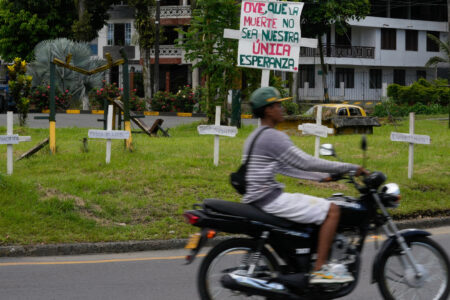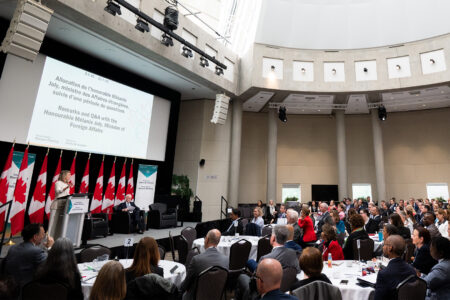
With an estimated 3 million people moving into urban areas each week, mainly in the global South, the percentage of urban dwellers will only continue to grow. The share of poverty in rural areas is still higher than that in urban areas, but the trend lines suggest poverty will steadily become a more urban problem. While rapid urbanization is often associated with megacities, most of the growth is actually occurring in small- to medium-sized cities (with less than 600,000 inhabitants). These urban areas often attract less investment and have a smaller tax base to finance investments in necessary infrastructure and services for their growing populations, which usually are insecurely housed and have no formal employment.
Despite these trends and the challenges of urbanization that accompany them – challenges like violence and inadequate housing and public health — cities are still only marginal actors in the execution of annual international aid flows of US$135 billion. This is because of the failure by donors to adapt to the changing demographics, as well as slow-moving diplomatic norms that have traditionally discouraged direct connections between donor institutions and local governments. The principles of development effectiveness emphasize a co-operative approach that involves the participation of all actors, yet local governments are too often forgotten.
Fortunately, an important moment to change gears will occur next month as government representatives, civil society organizations, academics and practitioners prepare to convene in Quito, Equator, for Habitat III, the United Nations Conference on Housing and Sustainable Urban Development. Participants will have plenty to catch up on, considering that the last Habitat Conference was held when “The Macarena” topped the billboard charts, in 1996. Much has changed in the intervening 20 years, and Habitat III will provide an opportunity to refocus international development assistance to address urban poverty more effectively. Two changes to the donor approach to sustainable urban development would help achieve success.
Development actors have been slow to acknowledge the evolving urban realities and adapt funding models and policy approaches to these realities.
First, donors need to ensure that development dollars are addressing the challenges of urban poverty. Development actors have been slow to acknowledge the evolving urban realities and adapt funding models and policy approaches to these realities. The sluggish response by donors to urban poverty can be explained in part by cultural inertia. Development assistance grew during an era when the vast majority of people who lived in poverty were rural inhabitants. Interventions were often discrete and tangible – a well drilled, a schoolhouse built. Systems of monitoring and evaluation were developed around such projects, encouraged by the more recent focus on demonstrating results for dollars spent. While evidence-based policy approaches to development assistance has brought benefits, they can discourage efforts in urban environments where establishing control groups and measuring the impact of a single intervention is more difficult.
Given the increased complexity of working in urban contexts, donors need to be flexible with their priorities. For example, a donor focus on maternal health may need to consider investments in public transportation to bring women closer to health services or to facilitate access to nutritious food. The measurement of results needs to capture those connected policy objectives, and it cannot be limited to short-term and narrowly defined outcomes.
Second, donors need to involve local governments in decisions about the allocation and delivery of development assistance. Admittedly this is not an easy task. In recipient countries, the diplomatic round tables at which development assistance discussions occur take place in capital cities and are encircled by national officials, who may be hesitant to hand over control of development dollars to their municipal colleagues. Yet investments in education decreed by central governments may be rendered useless locally if security conditions do not allow teachers or students to move freely from home to school. To ensure maximum coordination and impact, aid flows must take account of needs on the ground. The legitimacy and capacity of local governments can be undermined when a donor chooses to support international organizations that deliver parallel goods and services to citizens. The risks entailed in circumventing local governments outweigh donors interests in “planting the national flag” on individual projects.
For many urban dwellers, proximity does not necessarily mean access to services, particularly in the informal settlements that are increasingly growing on the peripheries of cities.
Until now, some donors have given short shrift to urban development and so the opportunities to engage municipal government have been limited. There is a perception that the urban poor are always better off when compared to their rural counterparts, based on better access to employment opportunities, a wider range of services and the potential to escape poverty. However, these “urban advantages” are often overstated, as David Satterthwaite says in his article. For many urban dwellers, proximity does not necessarily mean access to services, particularly in the informal settlements that are increasingly growing on the peripheries of cities. Importantly, efforts to address endemic urban poverty need not come at the expense of rural interventions. Improved transportation corridors that are thoughtfully located in order to bring agricultural goods to market can benefit urban consumers and agricultural producers. Private investment and trade (capital flows that can dwarf official development assistance) can also play a key role, in the reduction of poverty in both country and city, if they are effectively managed by local governments.
Despite being the host of the first Habitat conference (in 1976), Canada has waxed and waned in its focus on urbanization and aid. Nevertheless, while Global Affairs Canada’s discussion paper for its international assistance review contains no mention of urbanization, there are reasons for optimism. Global Affairs and the International Development Research Centre have recently made funding commitments to humanitarian assistance and climate change that are aimed at bolstering municipal governments. If global developments are any indication, we can expect Ottawa and other capitals to strengthen their focus on urban areas. The United Nations’ recently adopted Sustainable Development Goals include a specific commitment to make cities safe, inclusive, resilient and sustainable, an objective that donors will need to address. The World Bank is in the process of conducting urbanization reviews to understand how different actors coordinate their investment decisions in urban settings.
Habitat III will build on this promise and establish a new urban agenda, with specific objectives and actions. Clearly, success will depend on donors’ willingness to change their approaches, in concrete terms. Establishing policy and programming strategies that reflect urban realities better, and ensuring local governments are active participants in setting development priorities, would be a good place to start.
Photo: Aleksandr Hunta / Shutterstock.com
This article is part of the International Assistance special feature.
Do you have something to say about the article you just read? Be part of the Policy Options discussion, and send in your own submission. Here is a link on how to do it. | Souhaitez-vous réagir à cet article ? Joignez-vous aux débats d’Options politiques et soumettez-nous votre texte en suivant ces directives.






